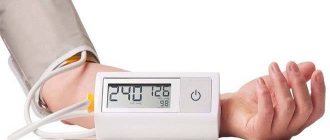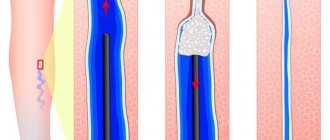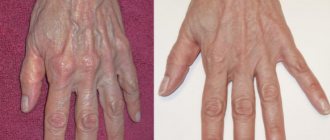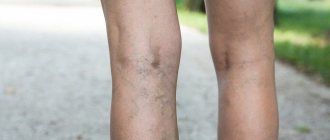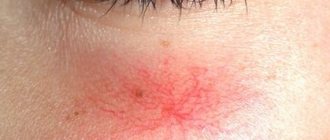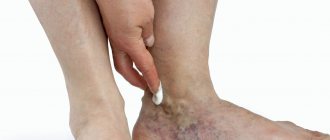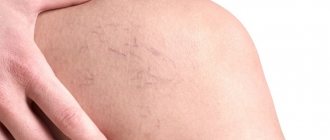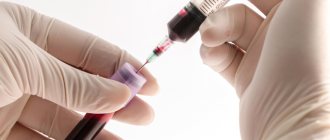Varicose veins are a common disease in the modern world, which is associated with a sedentary lifestyle, obesity and heredity. Patients, encountering this disease for the first time, simply do not know which doctor to contact for varicose veins in the legs, so they begin to self-medicate and significantly worsen their health condition. There is also an opinion that varicose veins are simply incurable, so many patients simply do not consider it necessary to seek medical help.
Today we will talk about what varicose veins are, we will talk about unpleasant symptoms that may indicate the appearance and development of the disease, and we will dwell on the questions of which doctor to contact with varicose veins in order to receive proper treatment.
Which doctor treats veins in the legs?
Many people have to deal with vascular diseases, namely varicose veins in the legs. The question immediately arises: which vein doctor is able to help cope with the problem and give competent advice. Unfortunately, this issue worries not only adults, but also the younger generation, since blood vessel diseases have become significantly younger.
An angiologist, phlebologist, and angiosurgeon will help in the fight against vascular pathologies.
When should you see a doctor for veins in your legs?
Pathologies of the cardiovascular system are quite common, and varicose veins take a leading position in the list of such diseases. Often people do not pay attention to the initial stages of the disease, and this complicates subsequent treatment. You should definitely consult a specialist if you experience the following symptoms:
- even after a short walk you feel heaviness in your legs;
- leg cramps occur during sleep;
- swelling of the lower extremities;
- burning sensation;
- the veins in the legs have become dilated (protrude);
- pain with slight pressure;
- a network of small vessels (stars) of blue, red or purple color is visible under the skin;
- pain in the lower extremities with exertion.
If a person is at risk, it is necessary to see a doctor, even if there are no obvious problems with the blood vessels. Factors that provoke pathologies of the veins in the legs include:
Strength sports can be a provoking factor for the development of the disease.
- great physical activity;
- doing strength sports;
- genetic predisposition;
- pregnancy;
- alcohol abuse;
- excess weight;
- consumption of fatty and spicy foods;
- old age.
Return to contents
Vein and Vascular Doctor
Often patients who have problems with veins or arteries do not know who to turn to. The vascular specialist depends on the location of the pathology and the nature of the lesion.
A therapist who has the patients’ medical records can help you choose the right doctor’s office. Most often, the veins of the lower extremities are affected.
A doctor who treats such diseases is called a phlebologist.
When should you apply?
When the first symptoms of a vascular system disorder appear, you should consult a doctor, as some diseases can be fatal.
Vascular diseases have different symptoms depending on their location. They can often be confused with diseases of the musculoskeletal system. Therefore, if discomfort in the limbs, dizziness or pain in the heart occurs, it is necessary to consult a therapist, who, having found out the clinical picture of the disease, will refer you for examination to a specialist.
Consultation with an angiologist
Depending on the characteristic symptoms, the doctor to whom you should contact is determined. If the arteries and lymphatic system are damaged, they consult a specialist called an angiologist. Such pathologies are manifested by the following symptoms:
You should visit an angiologist if you have pain in the limbs.
- decreased sensitivity of the skin of the extremities;
- tingling sensation in the affected areas;
- dysfunction of the joints of the arms and legs;
- pain in the affected limbs.
When will a phlebologist help?
This doctor specializes in diseases of the veins of the lower extremities. To make a final diagnosis, the doctor will prescribe an ultrasound and computed tomography scan of the affected area. With their help, he checks the condition of blood vessels and the presence of blood clots. The reasons to contact a phlebologist are the following signs:
- heaviness in the lower extremities with minor physical exertion;
- the appearance of swelling in the legs;
- a feeling of pain and burning in the area of the affected vessels;
- cramps in the calf muscles, which most often occur at night;
- vascular network and protrusion of veins, visible to the naked eye.
What abnormalities does a neurologist treat?
A preliminary diagnosis of cerebral vascular damage is made by a therapist. A doctor who deals with detailed diagnosis and treatment of such pathologies is called a neurologist. His consultation is necessary if the following symptoms occur:
If a person notices pain in his neck, then he needs to see a neurologist.
- pain in the neck and head;
- noise and ringing in the ears;
- chronic fatigue;
- temporary loss of orientation;
- short-term loss of consciousness.
Indications for visiting a cardiologist
If vascular diseases are associated with disruption of the heart, then in such cases it is necessary to consult with this doctor. Early-stage heart disease may not cause severe symptoms.
Therefore, serious heart pathologies are often diagnosed at an advanced stage. It is recommended to undergo a routine examination by a cardiologist at least once a year to prevent the development of complications.
Examinations are especially important for patients with problems with high or low blood pressure. Consultation with a cardiologist is necessary if the following symptoms appear:
- heartache;
- the appearance of shortness of breath;
- excessive sweating.
In what cases will a surgeon help?
In case of serious vascular damage, surgical intervention becomes necessary. A doctor who specializes in such manipulations is called a vascular surgeon. This specialist can prescribe conservative treatment and determine the need for surgery. Depending on the location of the pathology, it is necessary to contact various doctors:
DoctorSpecialization
| Vascular and general surgeon | Treats all diseases of the veins and arteries, except for damage to the blood vessels of the heart and brain |
| Cardiac surgeon | Treats heart diseases |
| Neurosurgeon | Specializes in pathologies associated with cerebral vascular lesions |
What treatment measures does the doctor prescribe?
Drug treatment is prescribed by a doctor who treats vascular diseases. Without its prescription, the use of drugs is contraindicated.
At the initial stage of vascular damage, conservative treatment is prescribed, aimed at eliminating such unpleasant symptoms as pain and a feeling of heaviness. For this purpose, medications are used to improve blood circulation and prevent the formation of blood clots and nodules.
If the veins of the extremities are affected, physiotherapy may be used. If the disease reaches an advanced form, then surgical intervention becomes necessary.
To prevent disruption of the circulatory system, it is necessary to lead an active lifestyle, give up bad habits and regularly undergo scheduled examinations.
Source: https://EtoVarikoz.ru/vas/doktor-po-venam-i-sosudam.html
Which doctor should I contact?
Vessels need help to supply all tissues and organs of the human body with nutrients and oxygen. Depending on the causes of their damage, contact the following specialists:
- Angiologist – diseases of the vascular system: phlebologist – vein pathologies;
- arteriologist - diseases of the arteries.
- Cardiologist - diseases of the cardiovascular system.
Return to contents
Angiologist
Angiology is a branch of anatomy and medicine. Studies the vessels of the circulatory and lymphatic systems. Their structure and functions, pathologies, diseases, diagnoses and prescribes preventive measures. The doctor working in this direction is an angiologist. As a rule, referrals to him are given by doctors of other specializations, since the cause of venous disorders in the legs is often associated with other diseases. This specialist treats the following diseases:
- vascular atherosclerosis;
- aneurysm;
- embolism;
- vasculitis;
- angiopathy;
- lymphostasis.
Return to contents
Phlebologist
Phlebology is a narrow medical field that studies venous vessels, their functioning and structure. A doctor who deals with problems of veins in the legs is called a phlebologist. He develops methods for diagnosing, treating and preventing diseases. His areas of expertise include the following diseases:
You need to see such a doctor if “stars” appear on your legs.
- thrombophlebitis (inflammation of the vessel wall with the formation of a blood clot);
- vascular defects, asterisks;
- chronic venous insufficiency (CVI);
- trophic ulcers;
- thrombophilia;
- thrombosis.
Delayed diagnosis and treatment of vascular diseases can lead to disability and even death.
The phlebologist conducts a thorough examination, which includes:
- Collecting complaints, compiling an anamnesis.
- Physical examination: general examination - swelling, varicose veins, presence of vascular pattern;
- palpation - pain, local rise in temperature.
- complete blood count - leukocytosis, increased ESR;
- ultrasound angioscanning;
For the treatment of venous disorders in the legs, the following are prescribed:
Vascular surgeon
If drug treatment does not help, then surgery is prescribed. An angiosurgeon (vascular surgeon) performs functional restoration of blood vessels, possibly removing the damaged area. The surgeon uses minimally invasive operating methods; microsurgery is a separate area. Such leg surgeries include:
- bypass;
- thrombectomy;
- balloon angioplasty;
- vessel prosthetics.
Return to contents
Features of the work of a vascular surgeon
Vascular surgeons perform endovascular operations, including coronary artery bypass grafting and carotid endarterectomy. The doctor treats various venous diseases. Considers thrombophlebitis, pathologies associated with narrowing of the arteries due to layers and inflammation of the internal walls.
Endovascular surgery reveals a number of advantages. Minimally invasive surgery reduces the risk of injuries and complications. Recovery after surgery is faster, without pain or risks. Such operations on the legs are less labor-intensive and more economical.
When there is a blockage, the intravascular surgeon performs vascular bypass surgery. Bypassing the area of veins with pathology, another or synthetic prosthesis is installed in parallel. Blood supply is restored. Using your own vein is called autovenous bypass.
It is possible to replace the affected area with another part of your own vessel or prosthesis, and remove the blood clot. Dilatation surgery allows you to increase the lumen of blood vessels. A balloon is inserted into the cavity under slight pressure. To mechanically maintain the lumen, a special metal “spring” is inserted.
What is the name of the doctor you should contact for diseases of the veins in the legs?
Varicose veins and other vascular diseases are quite common, so sooner or later you may need to seek medical help.
Everyone who notices problems with their veins asks the question: what is the name of the doctor who deals with vascular diseases? Several specialists are involved in the diagnosis and treatment of vascular pathologies: phlebologist, vascular surgeon, angiologist. Depending on the reasons that caused the disease and the characteristics of its course, the help of doctors of other specialties may be needed. The need for additional consultations is determined after the initial examination and collection of the patient’s medical history.
Phlebologist
The term “phlebology” refers to a direction in the field of practical medicine that studies anomalies and pathologies of the veins. Currently, this industry is actively developing, which is due to an increase in the level of detection of venous system defects in the population. Currently, problems of this kind are identified in almost every second average inhabitant of the planet, which determines the need to deal with the problem more closely.
When problems with veins arise, almost every patient is interested in the following question: which doctor to visit, which specialist will help make a diagnosis and prescribe an appropriate treatment option, and also what is the name of the doctor who treats veins. The presence of problems of this kind is a direct indication for visiting a doctor called a phlebologist. His narrowly focused professional activity covers venous pathologies.
How is diagnostics carried out?
During the first visit, the doctor conducts a visual examination of the patient, collects anamnesis and prescribes the laboratory and instrumental tests necessary to make an accurate diagnosis. First of all, a coagulogram is performed - a study that helps to establish such parameters as blood clotting activity and its speed. Hardware techniques include ultrasound scanning of affected areas, phlebography (x-ray with a contrast agent injected into the vein cavity), phleboscintigraphy (assessment of blood flow inside the veins).
What treatment can a phlebologist prescribe?
The doctor selects a treatment method based on information about the patient’s condition, the results of the examination and the location of the disease.
Treatment of varicose veins and other vascular pathologies can be carried out in one of the following ways:
- Conservative therapy consists of using medications for external and internal use.
- Wearing compression hosiery makes it possible to improve blood flow through the vessels and prevent their further deformation, alleviating the patient’s general condition.
- Scletotherapy is used to seal small varicose veins and consists of introducing a special chemical into the vascular cavity that glues the venous walls together.
- Laser coagulation allows you to treat varicose veins without damaging the skin and deeper tissues. Under the thermal influence of laser radiation, obliteration of the affected vessel occurs and its further resorption.
How a phlebologist treats varicose veins
Treatment depends on many factors: the general condition of the patient, the severity of symptoms, the severity of the disease, and the location of the pathological process.
The following treatment methods for varicose veins are currently used:
- Conservative therapy. The patient is prescribed drugs for internal use and local agents in the form of gels and ointments.
- Compression jersey. Special elastic underwear normalizes blood flow, prevents swelling, and alleviates the person’s condition.
- Sclerotherapy. Indicated for sclerosis of small veins. Prescribed only after a thorough examination in the absence of contraindications. A special medicine is injected into the vessel, which glues its walls. The lumen closes and the vein is removed from the circulatory system.
- Operative methods. These include phlebectomy and the less traumatic miniphlebectomy. A phlebologist-surgeon performs the operation. During surgery, the affected section of the vein is removed.
- Laser coagulation. The operation is performed on perforating and superficial veins and is performed without incisions. The method is based on the thermal effect of a laser beam on the inner surface of the vessel, resulting in closure (obliteration) of the vein. This method has contraindications, including severe atherosclerosis, anemia, renal and heart failure, and increased blood clotting.
How a vascular surgeon can help
Another doctor who treats various vascular diseases is a vascular surgeon. This is a specialist who diagnoses, treats, and also deals with the prevention of various pathological processes occurring in the veins and arteries.
You should consult a doctor of this specialty if you have the following symptoms:
- pain syndrome in the lower or upper extremities;
- visible enlargement and change in color of blood vessels;
- formation of compactions in the subcutaneous layers, redness of the skin;
- wounds that do not heal for a long time;
- discoloration and tissue necrosis on the legs.
A vascular surgeon checks the movement of blood through the vessels, prescribes a series of tests and makes an accurate diagnosis.
After the initial examination, the patient may be referred for examination, which usually includes:
- clinic and blood biochemistry;
- coagulogram;
- ultrasound scanning of vascular lumens;
- angiography;
- sonography.
In most cases, patients turn to a doctor of this specialty in the last stages of the disease, so treatment is carried out in more drastic ways. Which method will be chosen to eliminate the pathology depends on the patient’s well-being and the presence of indications and contraindications.
Your doctor may suggest one of the following surgical procedures:
- stem and puncture sclerotherapy (for deformation of the venous walls of the lower extremities);
- surgical intervention using minimally invasive technologies;
- echosclerotherapy (removal of damaged vessels using additional scanning).
Treatment can be carried out using gravitational surgery techniques. This method of surgical intervention allows you to restore varicose veins.
A vascular surgeon not only treats pathology, but also monitors the patient’s recovery during the rehabilitation period, selects appropriate physiotherapeutic procedures, as well as preventive measures to prevent relapses.
If you suspect vascular disease, you should immediately seek medical help. The sooner the doctor conducts an examination and prescribes treatment, the greater the likelihood of eliminating the disease without the use of radical methods. Postponing a visit to a specialist and independently using medications and traditional medicine methods can negatively affect the course of pathological processes.
When to contact a phlebologist
Heaviness, burning sensation and pain in the legs, the appearance of swelling and spider veins may indicate problems with the veins. If you have such symptoms, you should consult a specialist called a phlebologist. This doctor studies the normal and pathological movement of blood through the vessels of the lower extremities, determines the violation of blood outflow, determines the cause of the development of pathological processes and prescribes appropriate treatment.
A phlebologist diagnoses and treats the following diseases:
- varicose veins in the legs;
- chronic venous insufficiency;
- thrombosis.
Consultation with this specialist is necessary if you suspect the development of thrombophlebitis and pronounced trophic changes in tissue.
You should consult a doctor not only after symptoms of pathology appear. People predisposed to vascular diseases are recommended to undergo periodic preventive examinations. This will help identify deformed veins in the early stages of the disease and carry out treatment before irreversible changes occur in the legs.
What is the name of a leg vein doctor - who should I contact in the clinic for varicose veins?
Not everyone knows what a leg vein doctor is called. If you start having problems with your legs, for example, spider veins and veins appear on them, it means that your health is at risk and you need to urgently consult a phlebologist. The first symptoms that will confirm your guesses about the presence of the disease will be dilated blood vessels. It is the deformation of the veins that provokes varicose veins, which from a small problem can become a serious pathology, and you will definitely have to go to the clinic for it.
Signs of the disease
Varicose veins mainly affect the veins in the legs. This is due to the greater load on them compared to other parts of the body. It is important not to miss the onset of the disease. Learn to listen to your body. After all, it is always easier to prevent or treat the initial stage of the disease than the advanced stage.
Signs of varicose veins:
- Frequent fatigue of the lower extremities.
- Leg pain.
- Edema.
- The appearance of stars.
- Dilated veins are visually noticeable.
- At an advanced stage of varicose veins, trophic ulcers may appear.
If you notice any symptoms of varicose veins, it is better to consult a doctor immediately. Jokes with this disease are bad. Therefore, it is better to raise a false alarm than to allow varicose veins to develop and start treatment at an advanced stage, when only vein surgery can help.
How do varicose veins manifest?
Doctors called phlebologists have developed a whole list of symptoms that will 100% confirm your guesses about the presence of a similar problem. There is no point in arguing that each organism has its own signs of illness, which can occur either at the same time or separately from each other. Some of the symptoms go unnoticed by the patient without causing exacerbations. Only with the help of correct diagnosis can a doctor determine whether there is a disease and whether it needs to be dealt with. To do this, you need to go to the hospital at the first suspicion of vein damage. Exactly what signs will serve as a signal, usually the following are mentioned:
- A feeling of constant heaviness in the legs, which manifests itself most strongly towards the end of the working day. This suggests that the veins are already affected by varicose veins; the problem is called pre-varicose veins.
- After this, varicose veins begin to take on complicated forms: the formation of a vascular network, an increase in venous nodes, this directly depends on fatigue and overwork of the legs.
- The next stage is the appearance of small ulcers on the lower part of the leg. If tissue nutrition is insufficient, they will grow and enter the so-called permanent trophic stage.
- The last stage of venous damage is characterized by constant swelling in the legs, severe pain in the extremities, exacerbation of ulcers, and acute symptoms.
What other treatment methods will be offered?
In addition to surgery, there are other ways to treat varicose veins. A specialist may suggest you a technique called sclerotherapy. The advantage of this method is that there is no need for anesthesia; after the procedure, the stars and ulcers on the legs disappear without a trace. The technique consists of connecting small vessels using a special liquid. It seems to glue the injured veins together. If large vessels are also affected, local anesthesia is used. In this case, the vessels are sealed with laser beams.
In most cases, phlebologists are not the final authority when choosing a treatment method. They always consult with other doctors - a surgeon, a therapist, an allergist, especially in difficult cases. Such problems include advanced varicose veins, venous insufficiency, thrombosis, ulcers and lesions called thrombophlebitis.
If you have a hereditary predisposition to the occurrence of this disease, then visits to the doctor should become regular so that the specialist can identify the pathology at an early stage. It is the attending physician who performs the initial examinations of patients. At the same time, he does not differentiate by age of patients; increasingly, young girls who develop varicose veins after constantly walking in heels turn to the phlebologist.
How does a phlebologist make a diagnosis?
In most cases, the doctor collaborates with a diagnostician, whose task is to perform an ultrasound examination of the patient. While the ultrasound specialist (called ultrasound for short) performs his procedure, leg vein doctors visually check the condition of the vessels, interview the patient and collect the necessary information.
For a complete picture and a high-quality diagnosis, the phlebologist also turns to a specialist called an angiographist. He examines veins using x-rays. During the examination, he, together with the phlebologist, may prescribe the injection of a radiocontrast substance to the patient. If this procedure does not help to give an accurate diagnosis, the doctor turns to the following procedures:
- phlebography;
- phlebomanometry;
- duplex study;
- Phleboscintigraphy.
If you do not follow all the doctor’s recommendations regarding blood vessels, received after all diagnostic procedures, the treatment will be unsuccessful. First of all, you should give up taking hot baths, visiting a sauna or bathhouse, smoking and drinking alcohol, dousing yourself with cold water, overeating, uncomfortable shoes and too tight underwear. Excess weight, which doctors call obesity, affects the progression of varicose veins the most. The fact is that extra pounds prevent blood from flowing to your extremities and place more stress on your legs. For the same reason, doctors strongly do not recommend sitting on a chair or sofa with your legs crossed.
Observation by a neurologist
In case of circulatory disorders of the head, doubt often arises as to which doctor treats the cerebral vessels. These pathologies require mandatory monitoring . The neurologist will prescribe the necessary diagnostics and treatment regimen. Contact him with the following symptoms:
- headaches, noises and ringing in the ears;
- chronic fatigue;
- loss of orientation in space and consciousness for short periods of time.
It is important to make a diagnosis in time, because this will avoid serious complications. There are common pathologies in this area. These include:
Autonomic dysfunction. Due to disorders of the autonomic nervous system, the rhythm and frequency of breathing is disrupted, and blood pressure increases. Nausea, heartburn, and loss of orientation may occur. If symptoms become regular, you should consult a neurologist. He can prescribe a consultation with an endocrinologist if necessary.
- Stroke. Occurs due to restriction of blood circulation in a certain area of the brain. Manifested by nausea, dizziness, fainting. After resuscitation, the patient is monitored by a neurologist and an MRI is performed. Complications such as vascular dementia and dementia often occur, so timely medical care is important.
- Atherosclerosis. The disease is characterized by headaches, impaired cholesterol production, and thickening of the vascular walls. Blood circulation is impaired. All this leads to memory impairment. If the situation is neglected and treatment is not started in a timely manner, encephalopathy develops. To make an accurate diagnosis, the doctor prescribes a duplex examination, CT scan of the brain, lipid profile and blood test.
Features of the work of a cardiologist
In the field of cardiac function, a vascular doctor is called a cardiologist. To make a diagnosis, the doctor performs an ECG and a comprehensive examination.
You should contact a specialist if:
- shortness of breath;
- sweating;
- heart pain;
- tachycardia;
- high blood pressure.
To prevent heart disease, it is recommended to consult a doctor after 35 years of age, when planning pregnancy, the risk of a hereditary disease, and also if you are obese.
In what cases should you consult a doctor?
A phlebologist deals with diagnostics, prevention and direct treatment of possible problems with blood vessels. You should contact him if you notice the following signs of illness:
- severe pain and aching sensations in the lower extremities;
- the appearance of “stars” on the legs, as capillary lesions are called;
- obvious vasodilation;
- the appearance of redness and ulcers that do not heal for a long time;
- darkening of certain areas of the legs (tissue necrosis).
A phlebologist can use not only standard, but also radical methods to eliminate the problem in order to cure the patient. But first, he must have a basis on which the diagnosis will be based. To do this, doctors who treat veins in the legs use the following diagnostic methods: ultrasound, duplex sonography, x-ray. Sometimes a doctor needs to understand how well blood flows in the body, so a vascular surgeon may prescribe a biochemical test of blood and urine.
After diagnostic procedures, the patient is offered one of the following methods for treating problems of the lower extremities: minimally invasive surgery, stem and puncture sclerotherapy, echosclerotherapy.
As soon as you find out which doctor treats this problem, you need to seek help from the clinic. Only there a specialist who deals with vascular problems will be able to provide qualified treatment. Home methods of combating varicose veins (manual massage, cupping, wraps) in most cases only worsen the situation and are effective only at the initial stage of the disease.
About the disease
Varicose veins are a venous disease, as a result of which the vessels become inelastic and brittle, increase in size, manifested by the formation of unsightly nodes on the skin, the appearance of redness and hematomas in the area of the burst vessels, constant pain and discomfort in the extremities.
Diagnosis of varicose veins is better
All you need to do is start with an external self-examination of your feet at home. It is better to find photographs online that illustrate the development of varicose veins and compare your limbs with them. If in reality there are at least some similarities with the photograph, we can draw a conclusion about the development of the disease. Remember that this is not the only symptom; other signs of illness include:
- The appearance of painful sensations even with the slightest pressure on the veins.
- Similar sensations are common with internal varicose veins, when compression and deformation of the muscles occurs;
- The appearance of a burning sensation in the muscles;
- Visible purple streaks and stars on the surface of the skin. They appear at the initial stage of varicose veins, do not cause discomfort, but make the skin of the legs unattractive;
- Bursting pain, feeling of fatigue and discomfort;
- The appearance of age spots, peeling and irritation on the skin. These problems are associated with poor circulation in the extremities. Tissues experience constant oxygen starvation;
- If the disease is not diagnosed on time, trophic ulcers appear on the skin, blood vessels constantly become inflamed, blood clots form and blood vessels become blocked.
The appearance of painful sensations even with the slightest pressure on the veins The appearance of a burning sensation in the muscles
Visible purple streaks and stars on the surface of the skin
The appearance of age spots, peeling and irritation on the skin
Bursting pain, feeling of fatigue and discomfort
Varicose veins not only cause the patient physical discomfort from a constant feeling of pain and burning in the limb, but also look unattractive from an aesthetic point of view.
If you do not find out in time which doctor treats varicose veins in the legs, you can provoke the development of serious complications. In its advanced form, varicose veins threaten its owner with thrombosis, extensive bleeding and even death.
There is a separate section in cardiovascular surgery, within which the problem of varicose veins is studied and effective treatment methods are developed. A doctor for varicose veins is called a phlebologist. He diagnoses the disease, both at the initial and advanced stages, prescribes optimal treatment and offers preventive techniques that help prevent the development of the disease.
Which doctor should I consult if I have varicose veins in my legs?
Varicose veins are a serious disease that occurs quite often these days. There are many reasons for the pathology, including hereditary predisposition, increased stress on the legs, and poor lifestyle. If varicose veins are not treated, they can cause thrombosis, ulcers, and even limb amputation.
To prevent your legs from spinning, you need to go to the hospital at the first signs of pathology. Symptoms of varicose veins include swelling, cramps, and visible spider veins.
Who to go to
On the threshold of a medical institution, the first question pops up on its own. Why do varicose veins occur, which doctor treats them? Let's try to give a complete answer to this question.
At the reception desk you can easily find the working hours of the following doctors:
Each doctor has his own narrow specialization, but by combining all the symptoms and examinations, they will be able to provide the highest quality assistance in treating the disease.
Often, in the presence of varicose veins, additional diseases are added to the main disease. It can be:
You can’t do this without the help of dermatologists and physiotherapists. They will familiarize themselves with the primary doctor’s prescriptions and supplement them with their own, which will include ointments to moisturize the skin and procedures to improve blood outflow and circulation in the extremities.
Therapist
It is important to take care of your health and respond to any changes that occur in the body.
When they appear, you need to contact a therapist and get an appointment for urine and blood tests, which can give a more specific picture of the course of the disease. You should rush to see a therapist who can cure the disease if you have the following symptoms:
- the presence of nagging pain in the lower extremities at the end of the day;
- the appearance of the first vascular networks;
- unpleasant pain after physical activity and even walking;
- cramps at night;
- legs in the calf muscle area itch for no apparent reason.
It is important to pay attention to the fact that even if the veins are not yet visible, but the symptoms are already present, you still need to come to see a doctor. After passing all the required number of tests, the therapist refers the patient to a phlebologist for further treatment.
Situations often arise when the disease is at such a stage of progression that conservative treatment methods are no longer able to help. In this situation, a surgeon comes to the aid of the phlebologist.
Phlebologist
The main specialist who deals with varicose veins, but to get to him, you need to visit a therapist.
Surgeon
This doctor is consulted for surgical treatment of varicose veins. He prescribes additional tests and studies that will show the possibility of surgery.
It is not an ordinary surgeon who begins the surgical intervention, but an angiosurgeon. He works with veins, arteries, lymph nodes and performs operations on them. Their responsibilities include not only carrying out planned interventions, but also providing assistance in cases of injuries in which blood vessels are damaged.
After a certain period of time that the patient spends in the hospital, it is necessary to return to the clinic and see a phlebologist. The doctor is obliged to evaluate the work done and tell the person about the necessary measures to prevent the disease, which may include medication support and the use of various procedures.
Angiologist
In our country, an angiologist (a doctor who treats blood vessels) is extremely rare, but in the United States this position is very popular. Their main task is medicinal and conservative treatment of varicose veins.
Constriction of cerebral vessels: symptoms, causes, diagnosis, treatment
Often, when the first symptoms of an illness appear, a person “writes them off” to fatigue, change of weather, or emotional state.
In some cases, the reasons for poor health actually lie in all these factors, but sometimes we are talking about a narrowing of the blood vessels in the brain, and there is a need to treat the disease, because it can not only be painful, but in an advanced stage it can be very dangerous.
With this kind of disease, blood flow is hampered; accordingly, the brain does not receive enough nutrients and oxygen, which makes its functioning more difficult.
In medicine, this phenomenon is called dyscyclic encephalopathy.
Experts group the causes of cerebral vasoconstriction into two categories:
- Arterial hypertension. Older people are most often affected by the disease. When the symptoms of the disease are pronounced, there is a significant deterioration in blood flow. During periods of crises accompanied by pressure surges, small vessels are gradually destroyed, which negatively affects the functioning of the nervous system;
- Atherosclerosis. This disease has a destructive effect on large arteries (vertebral, carotid). The latter supply the brain with blood necessary for its normal functioning. If the cause of dyscirculatory encephalopathy is atherosclerosis, due to narrowing, the elasticity of the arteries decreases, and this leads to the appearance of cracks in them. In addition, thrombi, which are blood clots, can form in such arteries. In the case of significant growth of the blood clot, the blood flow can be completely blocked, so necrosis of the tissues of the vessels of the head and tissues can be observed, which as a result stop receiving blood. This condition is called necrosis and can cause a stroke.
Sometimes both of these ailments are provocateurs of dyscyclic encephalopathy, and the course of the disease becomes more complicated.
The consequence of vasoconstriction can be a stroke if it occurs suddenly. In some cases, the attack ends in the death of the patient.
Another condition that the disease can lead to is cerebral ischemia. The disease occurs in several stages, which usually takes about several years.
The initial reasons that can provoke a narrowing of cerebral vessels are:
- Sedentary lifestyle, insufficient exposure to fresh air;
- Poor nutrition, excess weight;
- Bad ecology;
- Blood diseases, oncology, diabetes mellitus, diseases of the musculoskeletal system;
- Heredity can also cause vasoconstriction;
- Having bad habits.
Before treating the disease, it is necessary to diagnose it, including taking into account the following symptoms:
- Hypotension or hypertension;
- Dizziness, fainting may occur;
- The patient often suffers from severe headaches;
- Impaired balance and coordination of movements;
- Sleep disturbance;
- Numbness of the limbs, in some cases they lose sensation.
Several methods are used for it, which complement each other.
Before prescribing treatment, it is necessary to undergo an examination, which includes:
- Inspection. Thanks to it, the doctor can obtain a lot of data about the patient’s condition. During the examination, the specialist determines whether there are neurological changes, disturbances in the functioning of the cardiovascular system, or respiratory parameters;
- Dopplerography. Using this diagnostic technique, the doctor directly determines the structure of the vessels, their anatomy, as well as the speed at which the blood moves. This study helps to identify existing changes in the circulatory system that have formed due to plaques, blood clots, or due to any physiological characteristics;
- Before starting to treat cerebral vessels, CT angiography and MR angiography are also prescribed. These studies can detect blood flow disorders.
Often, in the fight against the disease, drugs that help thin the blood are used. The most commonly prescribed medication is Aspirin. However, you cannot prescribe it yourself, since when treating vasoconstriction, it can aggravate the course of other diseases, in particular those that are accompanied by bleeding.
The specialist determines the treatment strategy individually after the study. Sometimes people do not know which doctor deals with this problem - he treats the blood vessels of the brain. When you notice the first symptoms and want to get examined, you can first contact a therapist.
Considering that the disease can be caused and can also provoke other diseases, the problem can be dealt with by doctors such as a neurologist, cardiologist, phlebologist, or therapist. The latter will determine which doctor you need. In some cases, the help of several specialists is needed.
What therapy can they prescribe?
- Iodine therapy;
- Antioxidants, trace elements, vitamins;
- Drugs that have a vasodilating effect (Papaverine, Eufillin) are also used for treatment. Each of the medications in this group treats by expanding the lumen of blood vessels;
- The consequence of the disease is often osteochondrosis, for the treatment of which massages and gymnastics are prescribed. These methods help normalize blood flow.
Statins, fibrates, and anion exchange resins are also used to combat the disease. All these methods are used to treat cerebral atherosclerosis and, in particular, drugs such as Falipamil, Lacipil, Adalat, Telektol, Vincetin, etc. are used.
It is also necessary to use preparations containing silicon, potassium, and selenium. These elements help strengthen the walls of the arteries.
If conservative therapy does not bring results, surgery may be indicated to remove plaques.
One of the unpleasant phenomena that can accompany the disease is spasms that occur against the background of the disease due to temperature changes and weather changes. They occur against the background of osteochondrosis, smoking, alcohol abuse, and overwork. Age also plays an important role - the older a person is, the more susceptible he is to this phenomenon.
There is a need to treat spasms of cerebral vessels, because they can lead to hemorrhage, stroke, and aneurysm.
You can help yourself at home using the following methods:
- Washing with cold water;
- Massage of the back of the head, temples;
- Foot bath with cold water;
- Warm water with honey.
If you have a spasm, you must lie down with a pillow under your head.
Perhaps the most famous remedy is alcohol. We are talking about small quantities of alcohol – approximately 30-50 g/day (no more).
One of the remedies for treating cerebral vessels that traditional medicine offers is garlic.
The medicine is prepared as follows:
- Garlic in the amount of 1 head must be crushed so that it acquires the consistency of gruel.
- The resulting slurry should be poured with vegetable oil (200 ml), and let the mixture stand.
- After a day, add 1 tsp to the mixture. lemon juice.
- You need to take the medicine in a dosage of 1 tsp. every morning.
Duration of treatment is 3 months
Oils (sea buckthorn, lavender, jasmine oil) are also effective folk remedies.
Any of them must be taken daily for 2 weeks before eating in the amount of 1 tsp.
Herbs such as St. John's wort, hawthorn, mint, fireweed, and lemon balm have proven themselves, and should be consumed instead of tea several times a day.
The same folk remedies can relieve spasms.
Nutrition plays an important role in the fight against disease. It should be balanced, rich in vitamins, beneficial elements, and fiber. It is necessary to consume vegetables, fruits, herbs, legumes, and fish.
Whatever medications you use to alleviate your condition when symptoms of the disease appear, consulting a doctor if you have this problem is extremely necessary.
The materials posted on this page are informational in nature and intended for educational purposes. Site visitors should not use them as medical advice. Determining the diagnosis and choosing a treatment method remains the exclusive prerogative of your attending physician.
Source: https://allergology.ru/zdorove/suzhenie-sosudov-golovnogo-mozga
I do not want to go
Many people are not even going to go to the hospital, even the symptoms of the disease are already very pronounced. The reasons for this are fear. It constrains a person and he cannot decide to seek help when the disease is at an early stage and can be prevented. They do not know which doctor to contact for varicose veins and what needs to be done first.
Most often people are afraid of:
- The unknown. The lack of education of patients paints scary pictures of examinations in their imagination, and the first thing they do is only an ultrasound, which does not bring any pain.
- Carrying out surgery. No more than 10% of all patients in whom there is a threat to life or conservative therapy does not bring the desired result end up on the surgeon’s table. In other cases, treatment consists of taking pills, using ointments, or wearing compression stockings.
- Mistrust of the doctor and lack of knowledge of where to turn. So, a phlebologist is involved in the treatment. To choose a doctor, ask about his documents (diploma, certificate), check his work experience, and find out real patient reviews.
- Patients worry about the cost of treatment. It is important to remember that if the form of varicose veins is neglected, treatment will be longer and more expensive, which means that the sooner you contact, the less money you will have to spend.
Now you can easily decide which doctor to see for varicose veins, overcome your fear and boldly begin to fight the disease. It is important to remember that if you consult a specialist in a timely manner and carry out preventive measures, you can avoid many of the problems that varicose veins bring with you.
Which doctor treats cerebral vessels?
20.03.
2019
Cerebrovascular diseases are mainly manifested by chronic nonspecific brain symptoms, including headache, dizziness, constant fatigue, sleep disturbance, irritability, frequent mood changes and decreased cognitive processes. In some acute conditions, for example, during a hypertensive crisis, ischemia and stroke may occur. These pathologies are manifested by focal neurological symptoms, for example, speech disorder, seizures or loss of visual fields.
In order to prevent vascular diseases and complications, you should know which doctor to consult when the first symptoms appear.
Which doctors can help?
The choice of doctor's specialization depends on the clinical picture formed during the disease. So, these are mainly therapeutic doctors: neurologist, phlebologist, cardiologist. These are also surgeons, for example, an angiologist. These doctors study the clinical signs of vascular diseases, diagnose them, and treat them.
However, in order for the attending physician to cure, the cause of the pathology must first be identified.
Which doctor checks blood vessels? Diagnostics can be prescribed by any clinical specialist who needs data on the functioning of cerebral vessels.
The vessels are directly checked by a radiation or functional diagnostics doctor who examines the arteries and veins using ultrasound or magnetic resonance imaging using angiography.
